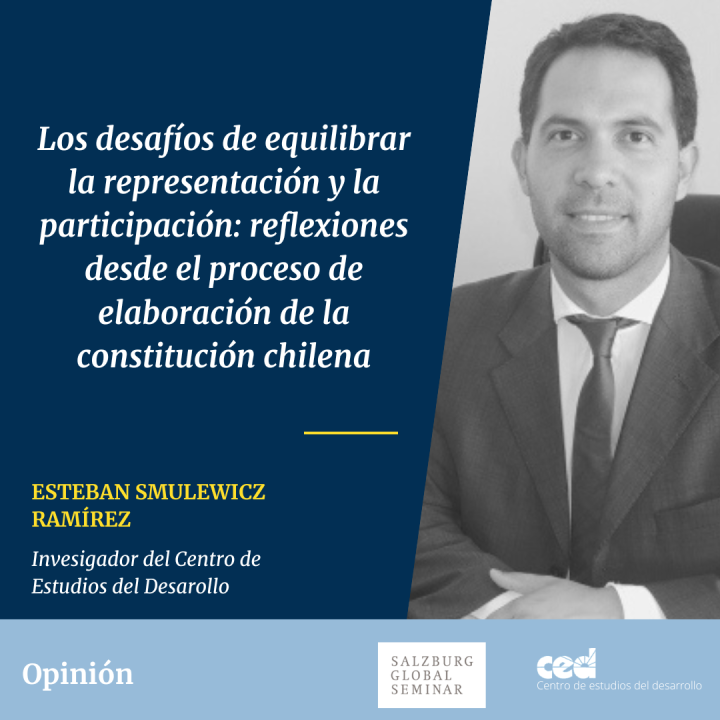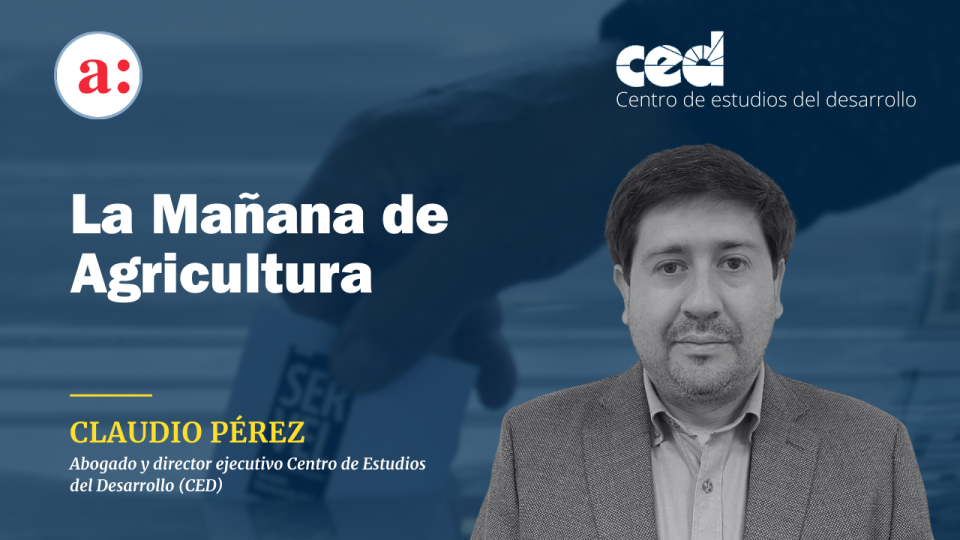
Ministro de Economía, Nicolás Grau, participa en Diálogos Público-Privado
Junio 22, 2023
CED participó de “Diálogos Tributarios 2023: Acuerdos transversales hacia un pacto tributario”
Junio 29, 2023Los desafíos de equilibrar la representación y la participación: reflexiones desde el proceso de elaboración de la constitución chilena

Por Esteban Szmulewicz Ramírez.
La columna fue publicada el 26-06-2023 en Salzburg Global Seminar
This op-ed is part of a series, written by Fellows and speakers of the Salzburg Global Weekend, with the theme “Democracy on the Front Lines”.
On September 4, 2022, after almost two years of profound and sometimes heated conversations, the people of Chile finally went to the polls to vote on a proposed new Constitution. It was the first time in Chile’s history that a fundamental social pact was being written and discussed in a fully democratic manner: the people had elected a Constitutional Convention and a great deal of effort was focused on inclusion and participation. The electoral rules for the Convention contemplated gender parity, reserved seats for indigenous people, accounting for more than 10% of the Convention, and a significant presence of a wide variety of societal interests.
Additionally, several instances of participation were introduced, such as citizens’ initiatives of constitutional norms, public hearings including decentralized sessions in remote areas, among many others. Citizens had the opportunity to follow the day-to-day workings of the Convention by a special online TV channel. The process for elaborating this new social pact seemed to resonate with the ideas of participatory and deliberative democracy supported by the international community (OECD 2020) and it has been considered innovative in terms of inclusion and citizens’ participation.
It is all the more puzzling, then, how the process transited from an almost 80% approval of the idea of a new Constitution (in an initial referendum in October 2020) to a 62% rejection of the proposed text in the September 2022 referendum. Even more striking, the support for the proposed new Constitution gained majority support in only eight out of the 346 municipalities in the country, and in the poorer areas the difference was even larger than in more well-off localities, in favor of the rejection.
Considering that democracies everywhere are facing enormous legitimacy challenges and in their capacity to effectively govern the complex 21st century problems, how can citizens reconnect with the representative institutions? How can declining trust in the democratic political system be rebuilt in the face of perma and poly crises, especially if participatory mechanisms are devised and used at its most, but still failed to deliver, like in the Chilean case?
A first step is the necessity to recognize the magnitude of the challenges and their complexities. For instance, a recent paper by Ionica Berevoescu and Julie Ballington (2021) acknowledged that despite major gains in democratic innovation and inclusion, women still remain highly underrepresented in politics, with over three quarters of the world depicting less than 30% of women incorporated in parliament. In an even worst situation are indigenous people and marginalized communities, which is where democratic innovations like the recent Chilean process might still propose interesting practices to help close the gap between political realities and the democratic ideals underneath.
A second insight is that we have to consider the cyclical nature of certain processes and how this can shape our understanding of them. The Chilean constitution-making process was a response to a severe crisis of representative institutions, manifested in massive and critical protests by the end of October 2019 that mobilized millions of people into the streets and posed a real threat of government breakdown. Therefore, the institutionalization of this severe societal conflict into a peaceful democratic process is positive, even if it has not yet resulted in the expected new Constitution. Even after last year’s referendum, political parties in Congress rapidly agreed in a new attempt at constitution-making, currently on its way, and the Expert Commission that emerged from it reached a consensus from alt-right to the communist party, just last month, on a new draft Constitution that is now being debated by an elected Constitutional Council. We will now have to wait for a new referendum in December of this year to see if the text elaborated by this new process is approved by the people, but the fact that the political system was able to channel both the large and massive protests and the rejection result of last year, speaks to me on the resilience of democracy and its capacity to self-learn, while at the same time the necessity to avoid the so-called “confidence trap” (Runciman 2015).
Lastly, if these participatory innovations are to have a real impact on our societies, they need to be considered in the larger scheme of democratic politics. Social movements need to engage with political elites and political parties. As Eisenstadt, Levan and Maboudi (2017) show, well-developed social movements are necessary but far from sufficient: they benefit from mediation, both from interest groups, as well as from political parties. Regardless of the wave of criticisms they have been facing in recent decades, political parties are still indispensable for the democratic process (Szmulewicz 2019). In the same line, elections are crucial for processing conflicts, but political life never stops and what happens between elections is relevant. Elected bodies should not take their mandate for granted and should continue speaking with civil society, the opposition, and diverse societal interests (Przeworski 2019), as shown by the polarizing turns in the recent electoral super cycle in Chile.
Considering last year’s Chilean experience, which failed to adequately balance representation and participation, how can citizens’ inclusion and participation mechanisms feed into the representative circuit, so that the entire scheme functions to further reconnect citizens with democratic institutions? Or, as the distinguished democratic theorist Carol Pateman (2012) has said, how to make participation work so that citizens can see an impact of their contributions, while at the same time representative institutions properly manage the complex climate of uncertainty, uneasiness, and the mounting challenges of the 21st century democracies on the front lines, keeping a constant deliberation with civil society? More than providing direct answers, the Chilean ongoing experience helps us pose the right questions and focus on finding the adequate balance between participation and representation for the effective and democratic governing of our societies.
I am grateful to Aurore Heugas for valuable editing, and to Helia Nazari and Mary Helen Pombo for their motivation. Naturally, any mistakes are mine.
Esteban Szmulewicz Ramírez, investigador del Centro de Estudios del Desarrollo




